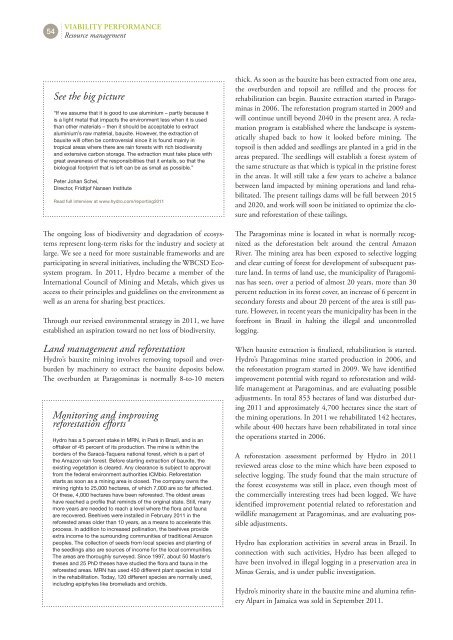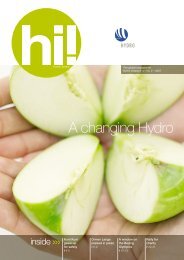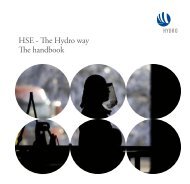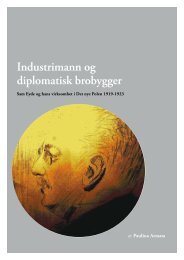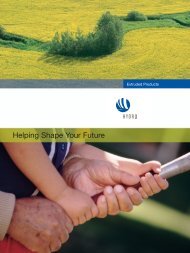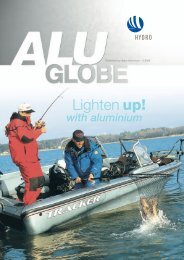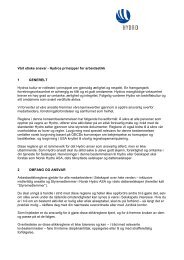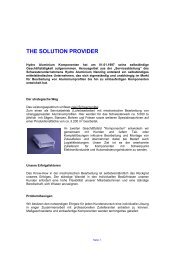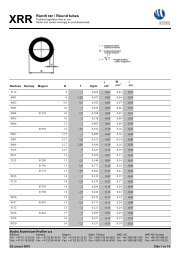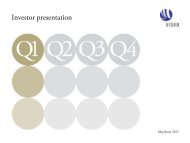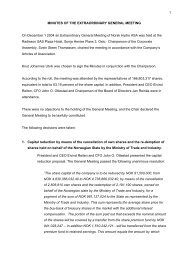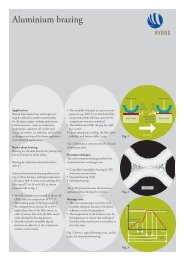Hydro Annual Report 2011b
Hydro Annual Report 2011b
Hydro Annual Report 2011b
You also want an ePaper? Increase the reach of your titles
YUMPU automatically turns print PDFs into web optimized ePapers that Google loves.
54<br />
vIABIlItY perForMAnCe<br />
Resource management<br />
See the big picture<br />
“If we assume that it is good to use aluminium – partly because it<br />
is a light metal that impacts the environment less when it is used<br />
than other materials – then it should be acceptable to extract<br />
aluminium’s raw material, bauxite. However, the extraction of<br />
bauxite will often be controversial since it is found mainly in<br />
tropical areas where there are rain forests with rich biodiversity<br />
and extensive carbon storage. The extraction must take place with<br />
great awareness of the responsibilities that it entails, so that the<br />
biological footprint that is left can be as small as possible.”<br />
Peter Johan Schei,<br />
Director, Fridtjof Nansen Institute<br />
Read full interview at www.hydro.com/reporting2011<br />
The ongoing loss of biodiversity and degradation of ecosystems<br />
represent long-term risks for the industry and society at<br />
large. We see a need for more sustainable frameworks and are<br />
participating in several initiatives, including the WBCSD Ecosystem<br />
program. In 2011, <strong>Hydro</strong> became a member of the<br />
International Council of Mining and Metals, which gives us<br />
access to their principles and guidelines on the environment as<br />
well as an arena for sharing best practices.<br />
Through our revised environmental strategy in 2011, we have<br />
established an aspiration toward no net loss of biodiversity.<br />
Land management and reforestation<br />
<strong>Hydro</strong>’s bauxite mining involves removing topsoil and overburden<br />
by machinery to extract the bauxite deposits below.<br />
The overburden at Paragominas is normally 8-to-10 meters<br />
Monitoring and improving<br />
reforestation efforts<br />
<strong>Hydro</strong> has a 5 percent stake in MRN, in Pará in Brazil, and is an<br />
offtaker of 45 percent of its production. The mine is within the<br />
borders of the Saracá-Taquera national forest, which is a part of<br />
the Amazon rain forest. Before starting extraction of bauxite, the<br />
existing vegetation is cleared. Any clearance is subject to approval<br />
from the federal environment authorities ICMbio. Reforestation<br />
starts as soon as a mining area is closed. The company owns the<br />
mining rights to 25,000 hectares, of which 7,000 are so far affected.<br />
Of these, 4,000 hectares have been reforested. The oldest areas<br />
have reached a profile that reminds of the original state. Still, many<br />
more years are needed to reach a level where the flora and fauna<br />
are recovered. Beehives were installed in February 2011 in the<br />
reforested areas older than 10 years, as a means to accelerate this<br />
process. In addition to increased pollination, the beehives provide<br />
extra income to the surrounding communities of traditional Amazon<br />
peoples. The collection of seeds from local species and planting of<br />
the seedlings also are sources of income for the local communities.<br />
The areas are thoroughly surveyed. Since 1997, about 50 Master’s<br />
theses and 25 PhD theses have studied the flora and fauna in the<br />
reforested areas. MRN has used 450 different plant species in total<br />
in the rehabilitation. Today, 120 different species are normally used,<br />
including epiphytes like bromeliads and orchids.<br />
thick. As soon as the bauxite has been extracted from one area,<br />
the overburden and topsoil are refilled and the process for<br />
rehabilitation can begin. Bauxite extraction started in Paragominas<br />
in 2006. The reforestation program started in 2009 and<br />
will continue untill beyond 2040 in the present area. A reclamation<br />
program is established where the landscape is systematically<br />
shaped back to how it looked before mining. The<br />
topsoil is then added and seedlings are planted in a grid in the<br />
areas prepared. The seedlings will establish a forest system of<br />
the same structure as that which is typical in the pristine forest<br />
in the areas. It will still take a few years to acheive a balance<br />
between land impacted by mining operations and land rehabilitated.<br />
The present tailings dams will be full between 2015<br />
and 2020, and work will soon be initiated to optimize the closure<br />
and reforestation of these tailings.<br />
The Paragominas mine is located in what is normally recognized<br />
as the deforestation belt around the central Amazon<br />
River. The mining area has been exposed to selective logging<br />
and clear cutting of forest for development of subsequent pasture<br />
land. In terms of land use, the municipality of Paragominas<br />
has seen, over a period of almost 20 years, more than 30<br />
percent reduction in its forest cover, an increase of 6 percent in<br />
secondary forests and about 20 percent of the area is still pasture.<br />
However, in recent years the municipality has been in the<br />
forefront in Brazil in halting the illegal and uncontrolled<br />
logging.<br />
When bauxite extraction is finalized, rehabilitation is started.<br />
<strong>Hydro</strong>’s Paragominas mine started production in 2006, and<br />
the reforestation program started in 2009. We have identified<br />
improvement potential with regard to reforestation and wildlife<br />
management at Paragominas, and are evaluating possible<br />
adjustments. In total 853 hectares of land was disturbed during<br />
2011 and approximately 4,700 hectares since the start of<br />
the mining operations. In 2011 we rehabilitated 142 hectares,<br />
while about 400 hectars have been rehabilitated in total since<br />
the operations started in 2006.<br />
A reforestation assessment performed by <strong>Hydro</strong> in 2011<br />
reviewed areas close to the mine which have been exposed to<br />
selective logging. The study found that the main structure of<br />
the forest ecosystems was still in place, even though most of<br />
the commercially interesting trees had been logged. We have<br />
identified improvement potential related to reforestation and<br />
wildlife management at Paragominas, and are evaluating possible<br />
adjustments.<br />
<strong>Hydro</strong> has exploration activities in several areas in Brazil. In<br />
connection with such activities, <strong>Hydro</strong> has been alleged to<br />
have been involved in illegal logging in a preservation area in<br />
Minas Gerais, and is under public investigation.<br />
<strong>Hydro</strong>’s minority share in the bauxite mine and alumina refinery<br />
Alpart in Jamaica was sold in September 2011.


